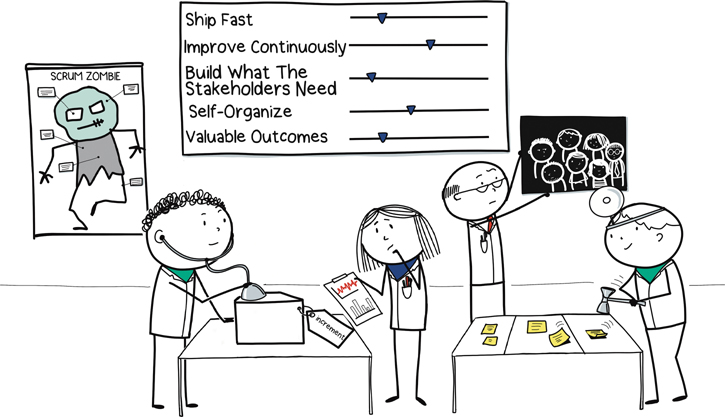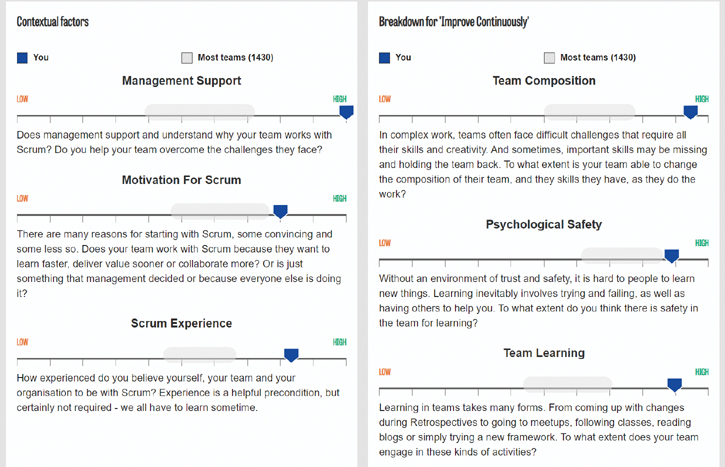What is Zombie Scrum
Experiment: Diagnose Your Team Together
Throughout this book, you’ll find many experiments and interventions that you can do with your team. They are all designed to help create transparency around what is happening, to allow inspection and encourage adaptation. Every experiment follows a similar pattern. We start with the purpose. Then we explain the steps and give direction on what to watch out for.
This first experiment is all about creating transparency and starting a conversation around Zombie Scrum (see Figure 3.6). This is a critical first step towards recovery and to confront the truth that work is needed. This experiment helps you progress on the first three steps of the First Aid Kit (Chapter 2): take responsibility, assess the situation, and create awareness.
This experiment is based on the Liberating Structure “What, So What, Now What?”1 It is a good way to build confidence, celebrate small successes, and build the muscle to get through the hard stuff.
Skill/Impact Ratio
Skill |
|
No skill is required for filling in a survey and inspecting the results together with your team. |
Impact on survival |
|
This experiment creates transparency around what is going on in your team (and around it) in terms of Zombie Scrum. It’s a crucial first step on your way to recovery. |
Steps
The following steps help you do this experiment:
Go to survey.zombiescrum.org and fill out the extensive free survey for your Scrum Team. Invite others from your team to join your “sample” as instructed. To protect others’ privacy and avoid abuse of the survey, scores from individual members are only shown to each survey taker.
When you’ve completed the survey, you’ll receive a detailed report (see Figure 3.7). The report will be updated every time someone joins the sample. In the report, you’ll find results for the four symptoms of Zombie Scrum, as well as a more detailed breakdown. The report also gives feedback and recommendations based on the results.
When everyone has participated, schedule a one-hour workshop to inspect the results together. We recommend doing this with only the Scrum Team: the Product Owner, the Scrum Master, and the Development Team.
Prepare for the workshop. You can print the report and hand out copies, put prints on the walls, or simply put up the profile on a screen.
Start the workshop by reiterating the purpose clearly and emphasizing what will happen with the outcomes (and what won’t). Make sure to emphasize that improvement is always a gradual, incremental, and often messy process and that this workshop is a step in that process.
Invite everyone to inspect the results silently and note down observations. Ask: “What do you notice in the results?” Encourage people to stick to the facts, and avoid jumping to conclusions, for the first round. After a few minutes, ask people to share their observations in pairs for another couple of minutes and notice similarities and differences. If you have eight or more people, ask pairs to join another pair and take a few minutes to share observations and notice patterns. Ask the small groups to share their most important insights with the whole group, and capture them in a way that remains visible to everyone present.
Following the pattern outlined in the previous step, repeat twice more with different questions. For round two, ask people “So, what does this mean for our work as a team?” For round three, ask people “Where do we have the freedom and autonomy to improve as a team? What are small, first steps we can commit to?” Make sure to keep capturing the most salient outcomes.
Put the most important actionable improvement on the Sprint Backlog for the next Sprint. Involve others as needed to keep making progress.
Our Findings
It can be tempting to identify dozens of potential improvements and end up doing nothing at all. Instead, keep a strong focus on improving one thing first before moving onto something else. If that improvement is too big to commit to doing it in a single Sprint, make it smaller.
When you ask people to participate in this survey, you’re asking them to trust you with their honest answers. Be deeply respectful of that. Don’t spread reports to people outside of the team or forward them to management unless you have clear and unambiguous approval from everyone involved.
Don’t use the report to compare teams. Doing so will erode trust much faster than you can rebuild it.



